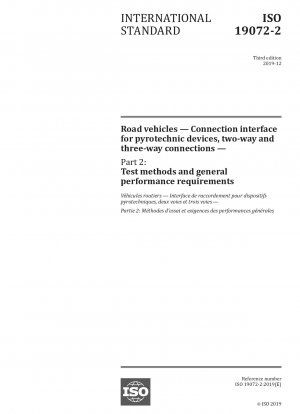ISO 19072-2:2019
Road vehicles — Connection interface for pyrotechnic devices, two-way and three-way connections — Part 2: Test methods and general performance requirements
- Standard No.
- ISO 19072-2:2019
- Release Date
- 2019
- Published By
- International Organization for Standardization (ISO)
- Latest
- ISO 19072-2:2019
- Scope
- This document specifies the performance criteria and requirements of a three-way connection interface, including ground connection, linking the pyrotechnic device and harness connector built into a road vehicle. Performance criteria and requirements are defined for a sealed variant of the pyrotechnic device/ initiator harness connector assembly (see Annex A). Performance criteria and requirements are defined for a two-way (without ground) variant of the pyrotechnic device/initiator harness connector assembly (see Annex B). Performance criteria and requirements are defined for a variant without a retainer of the pyrotechnic device/initiator harness connector assembly is defined (see Annex C).
ISO 19072-2:2019 Referenced Document
- ISO 20653 Road vehicles — Degrees of protection (IP code) — Protection of electrical equipment against foreign objects, water and access*, 2023-07-01 Update
- ISO 8092-2 Road vehicles — Connections for on-board electrical wiring harnesses — Part 2: Terminology, test methods and general performance requirements*, 2023-07-01 Update
ISO 19072-2:2019 history
- 2019 ISO 19072-2:2019 Road vehicles — Connection interface for pyrotechnic devices, two-way and three-way connections — Part 2: Test methods and general performance requirements
- 2013 ISO 19072-2:2013 Road vehicles.Connection interface for pyrotechnic devices, two-way and three-way connections.Part 2: Test methods and general performance requirements
- 2007 ISO 19072-2:2007 Road vehicles - Connection interface for pyrotechnic devices, two-way and three-way connections - Part 2: Test methods and general performance requirements
